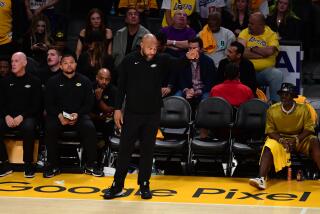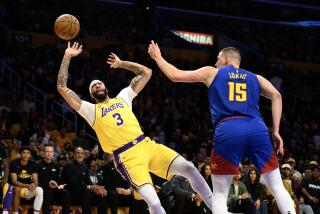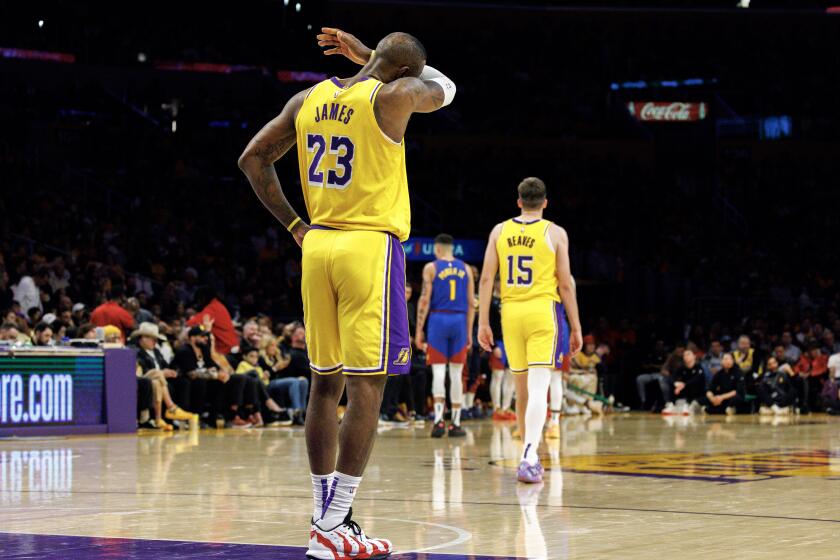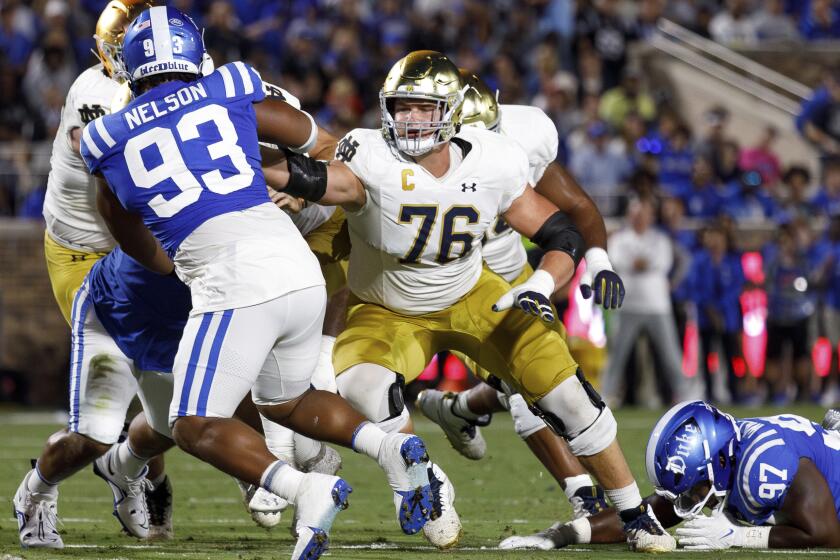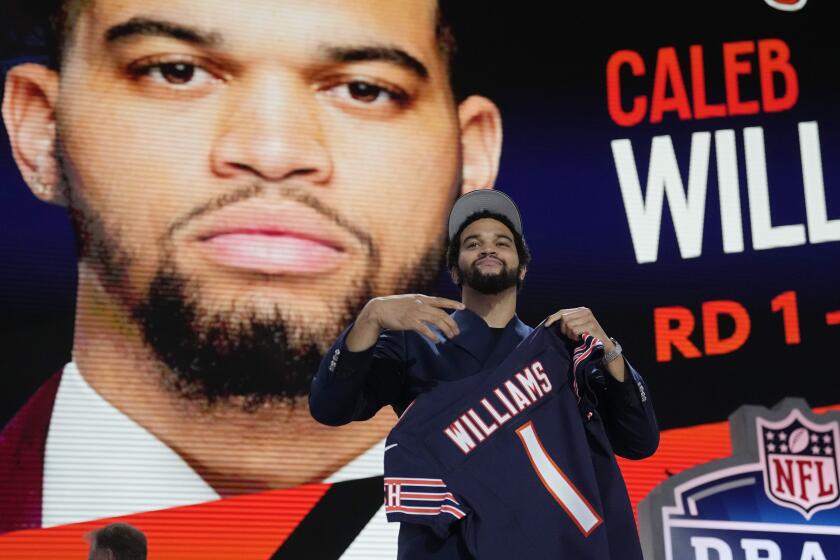20/20 vision? You might just be batting average
Pete Rose found baseball, at its essence, to be a simple game.
“See the ball,” he said. “Hit the ball.”
And nobody did that more often than Rose, the sports’ all-time hits leader.
But what if you can’t see the ball? That happened to Baltimore Orioles outfielder Jay Gibbons.
“My vision just went on me all of a sudden,” he said. “I was screwed.”
Same thing with Oakland’s Dan Johnson, who accidentally sprayed sunscreen into his right eye last spring and wound up with double vision.
“I used to hit breaking balls -- [until] I couldn’t see them,” recalled Johnson, whose batting average plummeted more than 40 points. He didn’t even try to hit curveball pitches, he said. “I would just take them, because I would lose them.”
Johnson did eye exercises during the off-season for up to six hours a day. The improvement showed in spring training, where he hit .294 with 10 walks before he ended up on the disabled list because of a hip injury.
The episodes proved to be eye-openers for both players who had always taken near-perfect eyesight for granted. Now, they’re among a growing number of professional athletes focusing on new and improved technologies to recover lost vision skills.
Not all the attention is coming from players with damaged or diminished eyesight. Even players with normal vision are turning to everything from laser surgery and tinted contact lenses to eye-strengthening exercises and high-priced “ocular” machines in search of a competitive edge.
“There’s so much technology with eyes now,” said Angels hitting coach Mickey Hatcher. “Players know that, hey, it’s worth spending the money.”
Or getting the team to spend the money, which is what Carlos Beltran did when he signed with the New York Mets before the 2005 season. Included in his $119-million contract was a clause that required the Mets to purchase an $85,000 “enhanced ocular device.”
The device is a high-speed pitching machine that fires specially marked tennis balls at speeds up to 155 mph. Players try to read the markings as the ball flies by, an exercise intended to improve both focus and concentration. The Kansas City Royals, Seattle Mariners, Chicago Cubs, Cleveland Indians and the Olympic champion U.S. women’s softball team have experimented with the ocular machine.
Another promising advance is the amber-tinted contact lens. Baltimore’s Brian Roberts, Dodgers minor leaguer James Loney and the White Sox’s A.J. Pierzynski are among dozens of players who have experimented with the lenses. They are designed to filter out specific wavelengths of light, cutting down on glare and making the ball appear more clearly.
See the ball better, hit the ball better -- at least that’s the theory.
“Obviously vision is huge in baseball,” said Roberts, whose batting average jumped 41 points in 2005, his first year seeing pitches through amber lenses.
“Everybody looks for an advantage any way you can get it,” he said, suggesting that vision training be added to physical conditioning regimens.
Loney, a career .280 hitter through his first four professional seasons, used the amber contacts for the first time last summer and led all of professional baseball with a .380 average at the Dodgers’ triple-A farm team in Las Vegas and had a stint with the major league club.
The relationship between good eyesight and baseball prowess has been known since 1921, when Columbia University researchers tested Babe Ruth’s vision and found the Yankee slugger’s eyes worked about 12% faster than those of an average person.
“Fundamentally he wasn’t the strongest. He wasn’t the best athlete,” said Dr. Bill Harrison, a leading sports vision specialist. “There was a lot of things that he was not. But he was the best visually. So there’s some kind of connection there.”
Even pitchers have found that their performance improved with vision enhancements. Greg Maddux, who won four Cy Young Awards wearing glasses and contact lenses, underwent eye surgery in 1999. He won nine of 10 starts after the procedure and the next season his strikeouts jumped and his earned-run average dropped more than half a run a game.
“After he got it, he said he could finally read the scoreboard,” said Leo Mazzone, Maddux’s pitching coach in Atlanta.
Mazzone, now the pitching coach in Baltimore, had no objections when hard-throwing Daniel Cabrera ditched his prescription goggles and underwent laser surgery on his right eye last fall, three days after a season in which he walked nearly seven batters for every nine innings pitched.
That’s the same surgery the Orioles’ Gibbons underwent two years earlier, improving his vision from 20/35 to 20/10. That means he once had to stand 20 feet from an eye chart to see what a normal person could see from 35 feet. Now, he can read from 20 feet what a normal person would have to move 10 feet closer to read.
“My eyes were always pretty good. And then all of a sudden I couldn’t catch fly balls,” Gibbons recalled. “Things were blurry.” But after the surgery his batting average improved by 31 points.
“Right away it was crystal clear,” he said. “I saw the ball so much better the next spring. I’ve never had any kind of problem since. It’s a no-brainer to me.”
But not everyone is sold.
Lasik is short for laser-assisted in situ keratomileusis, a 15-minute outpatient procedure in which surgeons use computer-controlled lasers to reshape the cornea. The procedure has some risks, including irreparable eye damage, that scares off some potential users.
Rick Griffin, head trainer for the Seattle Mariners, said advances in contact lenses have come so far that many players try them first, before opting for surgery.
“I don’t want to mess [my eyes] up and be blind,” said Marlins minor leaguer Reggie Abercrombie. He uses contacts to correct a severe vision problem he has had since high school.
“Without contacts I can hardly see anything. It’s made a big difference, going from seeing the ball as a blur to now just seeing the ball.”
And Abercrombie has a widening array of contact styles to choose from. In addition to the tinted models there are semi-permeable and soft lenses, hard lenses and even contacts with little weights in them that keep the lenses centered on the users’ pupil.
“They try everything, obviously, to get a little bit better,” trainer Griffin said. “A lot of people do specific eye training, eye exercises. Instead of going to the gym they do exercises to help their vision. It’s definitely something the players take very seriously.”
Griffin said former Mariner Edgar Martinez, a two-time American League batting champion and a seven-time all-star, owed much of his success to eye exercises he did throughout his 18-year career.
And Griffin spent part of this spring working with minor leaguer Juan Sandoval, blinded in his right eye when a drunk accidentally shot the pitcher in the face at a Dominican restaurant 14 months ago. After two surgeries and two visits to a retinal specialist, Sandoval is pitching again only because he has trained his left eye to compensate for deficiencies in his right eye.
“I see a lot of people do that,” Griffin said. “A lot of people do specific eye training, eye exercises.”
That kind of training has been around baseball longer than the designated hitter.
Vision specialist Harrison, a Laguna Beach optometrist, said he first approached Ewing Kauffman, the late Kansas City Royals owner, with the idea of vision training for baseball players more than 35 years ago. Kauffman was intrigued enough to let Harrison work with 20 minor league prospects.
One of them was a teenager from El Segundo named George Brett who would go on to win three batting titles and a spot in the Hall of Fame.
“I was always fascinated that a guy like Ted Williams could be so good and the rest of us weren’t very good,” said Harrison, who entered the University of California as a promising pitcher and left as an optometry student.
“So I was always interested in what role vision might play in the game.”
Harrison said he doesn’t try to improve a player’s eyesight as much as he tries to help players perform better with the vision they have by teaching them how to focus better and actually slow down the game visually.
“That ball is traveling at anywhere from 85 to 100 mph, so there’s not a lot of time to see it,” said Harrison, who has worked with Sean Casey, Barry Bonds, Sammy Sosa, Andruw and Chipper Jones and Jason Giambi, among others.
“Trajectory is involved. The speed, the spin. Then you tie in the travel and everything else you have to deal with, the fatigue issue and all of that, [and] it’s just a very tough visual task.
“What we try to do with players is teach them visual awareness.”
Last spring Harrison discovered Atlanta outfielder Matt Diaz had severe depth perception problems and gave him a series of exercises to correct them. Diaz batted .327 last season, 75 points above his career average.
“The players want the best equipment to play with and physically they want to have the best body,” Harrison said. “They [also] deserve to have the best eyes that give them a chance to perform.
“There’s a much greater awareness [of vision] today. There is a new frontier.”
Then there’s the Rigoberto Betancourt method. The former coach of Cuba’s national team taught pitchers to focus more sharply by having them throw while blindfolded.
But don’t expect to see that on major league pitching mounds anytime soon.
More to Read
Get our high school sports newsletter
Prep Rally is devoted to the SoCal high school sports experience, bringing you scores, stories and a behind-the-scenes look at what makes prep sports so popular.
You may occasionally receive promotional content from the Los Angeles Times.
